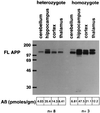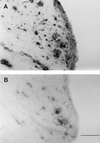Amyloid precursor protein processing and A beta42 deposition in a transgenic mouse model of Alzheimer disease
- PMID: 9037091
- PMCID: PMC19829
- DOI: 10.1073/pnas.94.4.1550
Amyloid precursor protein processing and A beta42 deposition in a transgenic mouse model of Alzheimer disease
Abstract
The PDAPP transgenic mouse, which overexpresses human amyloid precursor protein (APP717V-->F), has been shown to develop much of the pathology associated with Alzheimer disease. In this report, levels of APP and its amyloidogenic metabolites were measured in brain regions of transgenic mice between 4 and 18 months of age. While absolute levels of APP expression likely contribute to the rate of amyloid beta-peptide (Abeta) deposition, regionally specific factors also seem important, as homozygotic mice express APP levels in pathologically unaffected regions in excess of that measured in certain amyloid plaque-prone regions of heterozygotic mice. Regional levels of APP and APP-beta were nearly constant at all ages, while A beta levels dramatically and predictably increased in brain regions undergoing histochemically confirmed amyloidosis, most notably in the cortex and hippocampus. In hippocampus, A beta concentrations increase 17-fold between the ages of 4 and 8 months, and by 18 months of age are over 500-fold that at 4 months, reaching an average level in excess of 20 nmol of A beta per g of tissue. A beta1-42 constitutes the vast majority of the depositing A beta species. The similarities observed between the PDAPP mouse and human Alzheimer disease with regard to A beta42 deposition occurring in a temporally and regionally specific fashion further validate the use of the model in understanding processes related to the disease.
Figures





References
-
- Selkoe D. Annu Rev Neurosci. 1994;17:489–517. - PubMed
-
- Goate A, Chartier-Harlin M-C, Mullan M, Brown J, Crawford F, et al. Nature (London) 1991;349:704–706. - PubMed
-
- Chartier-Harlin M-C, Crawford F, Houlden H, Warren A, Hughes D, Fidani L, Goate A, Rossor M, Roques P, Hardy J, Mullan M. Nature (London) 1991;353:844–846. - PubMed
-
- Murrell J, Farlow M, Ghetti B, Benson M. Science. 1991;254:97–99. - PubMed
-
- Mullan M, Crawford F, Axelman K, Houlden H, Lilies L, Winblad B, Lannfelt L. Nat Genet. 1992;1:345–347. - PubMed
MeSH terms
Substances
LinkOut - more resources
Full Text Sources
Other Literature Sources
Medical

